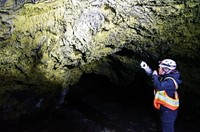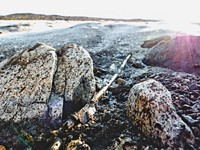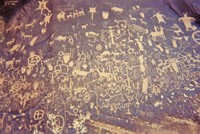Advertisement
Grab your lab coat. Let's get started
Welcome!
Welcome!
Create an account below to get 6 C&EN articles per month, receive newsletters and more - all free.
It seems this is your first time logging in online. Please enter the following information to continue.
As an ACS member you automatically get access to this site. All we need is few more details to create your reading experience.
Not you? Sign in with a different account.
Not you? Sign in with a different account.
ERROR 1
ERROR 1
ERROR 2
ERROR 2
ERROR 2
ERROR 2
ERROR 2
Password and Confirm password must match.
If you have an ACS member number, please enter it here so we can link this account to your membership. (optional)
ERROR 2
ACS values your privacy. By submitting your information, you are gaining access to C&EN and subscribing to our weekly newsletter. We use the information you provide to make your reading experience better, and we will never sell your data to third party members.
Environment
Tracing Earth History
An exploration of how fossil molecules can provide valuable clues to geological and biological history
by Bill Green
July 20, 2009
| A version of this story appeared in
Volume 87, Issue 29

 "Echoes of Life: What Fossil Molecules Reveal about Earth History"
"Echoes of Life: What Fossil Molecules Reveal about Earth History" is in many ways a remarkable book. At once a highly readable introduction to the field of organic geochemistry, it also manages to capture the deep sense of curiosity and wonder associated with scientific investigation.
Its lead author, Susan Gaines, is a novelist whose works include the highly regarded "Carbon Dreams" and whose academic background is in organic geochemistry and oceanography. Coauthors Geoffrey Eglinton, a renowned pioneer in organic geochemical research and professor emeritus at the University of Bristol, in England, and Jürgen Rullkötter, a professor at the University of Oldenburg, in Germany, provide technical depth, personal reflections, and insight into the array of topics woven together throughout this far-ranging and often charming work.
The subjects explored in the book involve the intimate relationships between organisms past and present and the evolving Earth that they have helped to create. The book is written in the spirit and tradition of the founder of biogeochemistry, the great Russian mineralogist Vladimir Vernadsky (1863–1945), whose view of nature argues for the strong linkage among Earth's living systems (biosphere), its rock-based geosphere, and its atmosphere and oceans. Through the wonders of organic chemistry, it is now possible to understand the behavior and environmental conditions of once-living organisms in the molecular traces, or biomarkers, they have left behind in rocks, sediments, and oils.

In 1936, the German chemist Alfred Treibs (1899–1983) was the first to realize that some of the molecules he had extracted from ancient rocks were, in fact, the altered remains of chlorophyll associated with ancient organisms. From this recognition, the concept of biomarkers—molecules such as the porphyrins and the abundant isoprenoids found in sediments, oils, and other geological materials—eventually developed. These molecules provide valuable clues about their own origins and about the conditions in which they were produced.
Although the topic of biomarkers may seem narrow, the authors show how these molecules can help to illuminate present and past developments on Earth and in the cosmos itself. The 11 chapters explore, among other things, the genesis of petroleum, the organic chemistry of moon rocks, carbonaceous meteorites and martian soils, the provenance of asphalt used in ancient mummification, and the state of precambrian oceans.
The central unifying idea here, the conceit of molecules as informants, has been nicely summarized by the authors: "If molecules can be witnesses, then the possibilities for what they have to tell us are endless. Not only can they tell us what the climate was during the last ice age, but they can provide clues as to what the early humans were eating at the time; they can tell us about the advent of life on Earth, or the presence of life on Mars, about the source of pollution in a bay, or the gasoline an arsonist used to start a fire."
What is unusual about this book, and what adds to its richness, is the way its subjects are discussed in terms of how science is actually practiced. To the authors, the journey seems nearly as important as the final destination, and so we are treated to a very human account of scientific research, with all its blind alleys, serendipity, personal quirks, and fortuitous meetings.
We learn, for example, that Eglinton's early fascination with the writings and voyages of Charles Darwin could have led to his initial interest in the chemistry of leaf waxes, a convenient batch of which was bequeathed to him in cigarette tins by the hundreds, by a retiring Cambridge University botanist. Maybe the pattern of n-alkanes could provide a fingerprint for individual plant species, Eglinton thought.
Just how unusual this pursuit was among organic chemists of the 1950s was captured by one colleague's query: " 'Why are you people working on n-alkanes?! They don't do anything!!' " As the authors tell us, even Eglinton had to agree with this assessment: Alkanes were, indeed, a bit boring. But by pursuing this unlikely avenue of research, he found scientific gold. As it turns out, odd-carbon n-alkanes, in the range C25 to C35 are characteristic of leaf waxes derived from higher land plants. This pattern distinguishes them from the n-alkane signature of marine phytoplankton. The humble n-alkanes can thus inform the geochemist of the origin of sedimentary marine organics.
It is easy in this book to detect the craft of the novelist. Not only is the language at times eloquent and colorful and enriched by analogy—"The mass spectrometer is a complex instrument based on a rather juvenile impulse: the best way to see how something is put together is to break it apart"—but there are also story lines that lead the reader to wonder how a particular investigation will turn out. How will the researchers ever put the pieces of this or that puzzle together? And what will the answer be? Of course, on occasion, it might take the reader some work to acquaint or reacquaint herself with terms and concepts drawn from an assortment of disciplines. But a range of terminology is to be expected in an interdisciplinary work of this breadth. And for the reader, understanding the process and the result—to say nothing of the suspense—is well worth the effort. This is natural history, science journalism, and mystery writing combined in a very satisfying mix.
Certain "biomarker stories," like those involved in the genesis of petroleum, can be more or less well-known, although not as completely and suspensefully rendered as in this book. Other case studies, I suspect, are far less familiar. For example, a rather recent collaboration between chemists and archaeologists has led to new insights into the history of ancient cultures. The authors recount a fascinating study of the origin of the black balm obtained from mummies in the British Museum, and they explain how this resulted in an understanding of the nexus between the Dead Sea asphalts and the art of mummification circa 200 B.C. to A.D. 150. Both the balm and the highly valued asphalt revealed similar sterane and hopane fingerprints. Later studies revealed that Dead Sea asphalts were being used in Egypt as early as 1100 B.C., suggesting an early date for trade between Palestine and Egypt.
It may surprise some readers that, in this day of intense investigations of martian soils and of the distant diaphanous galaxies seen through the Hubble Space Telescope, we are only now learning some of the key biological and chemical features in the evolution of our own ocean. Biomarker research has provided, among other things, valuable evidence for the hypothesis advanced by Donald Canfield of the University of Southern Denmark that the deep ocean was essentially anoxic during much of the early and middle Proterozoic—forming the "Canfield Ocean." Studies by Jochen Brocks of Australian National University in 2005 disclosed the presence of mid-Proterozoic sedimentary lipids associated with bacteria that could have flourished only in an anoxic sulfidic basin like that described by Canfield and comparable with today's Black Sea.
Additional biomarker research has centered on the fate and origin of pollutants in marine and freshwater environments. The late Max Blumer, of Woods Hole Oceanographic Institution, in a pioneering long-term study of an oil spill off the coast of Cape Cod, was able to show that certain organics persisted in the sedimentary environment long after visible signs of the spill had disappeared. And the biomarker approach has also made it possible to fingerprint oil from specific sources—tankers, rivers, seeps, and so forth—and to track its movement through the environment. Dinosterol in lake and marine sediments has proven to be a reliable indicator for the environmental chemistry of fertilizer runoff.
In consideration of the range of topics discussed, the authors have helpfully provided an extensive glossary and an appendix summarizing the major biomarkers, including their molecular structures; their known or postulated sources in bacteria, algae, and other organisms; and their biogeochemical applications. For example, the structures of pristine and phytane are shown and their role as indicators of the oxic or anoxic nature of an aquatic environment is summarized. There is a selected bibliography, a geologic timescale showing associated fossil molecules, and a host of schematics that embellish the text. The figure on page 95 showing the pathway from organisms to petroleum, gases, and carbonaceous residues is excellent. The major tools of the organic geochemist—the gas chromatograph and the mass spectrometer—are also explained in simple but informative diagrams. Epigraphs from Primo Levi, Louis Pasteur, Arthur C. Clark, Sir Arthur Conan Doyle, Dmitry Mendeleev, and many others add to the flair of the book.
Portrayed by the authors on occasion as a group of mavericks and considered early on by some traditional chemists as "stamp collectors," the organic geochemists and the biomarkers they have assembled and investigated, at times painstakingly, over the past seven decades, have emerged as valuable contributors to paleoceanography, climatology, oil exploration, microbiology, environmental chemistry, exobiology, and other fields. "Echoes of Life" deserves a wide readership, not only by practitioners of the sciences mentioned here but also by historians and philosophers of science who are interested in more than abstractions. The general reader or the student of science who wishes to see a dynamic and flourishing area of research as it comes into being will be amply rewarded. It is difficult to imagine this at-times challenging material being presented in a more lucid and literary fashion than it is here.
Bill Green is a geochemist and professor of interdisciplinary studies (emeritus) at Miami University, in Ohio. His book, "Water, Ice and Stone: Science and Memory on the Antarctic Lakes," was awarded the 1996 John Burroughs Medal in nature writing.





Join the conversation
Contact the reporter
Submit a Letter to the Editor for publication
Engage with us on Twitter